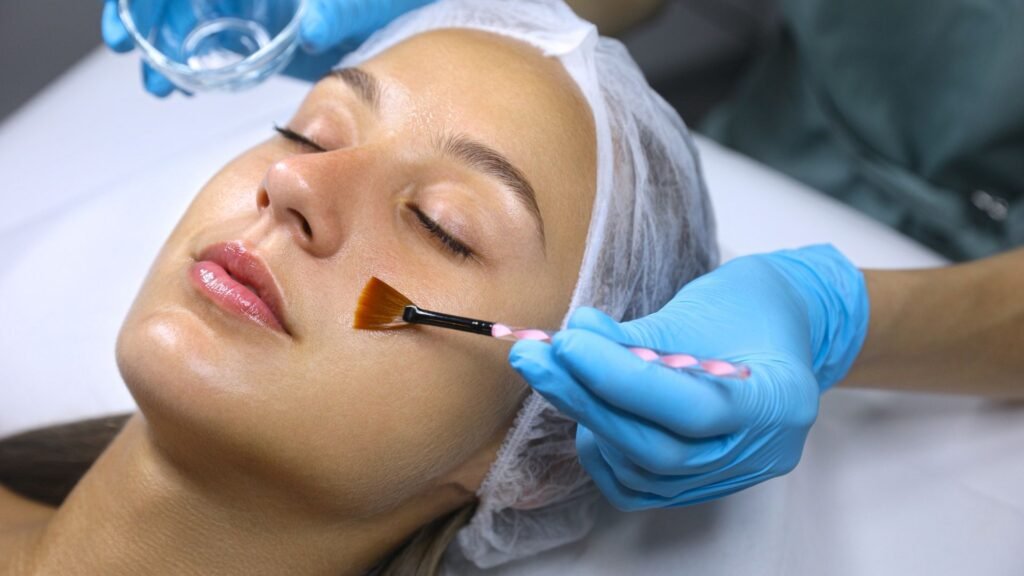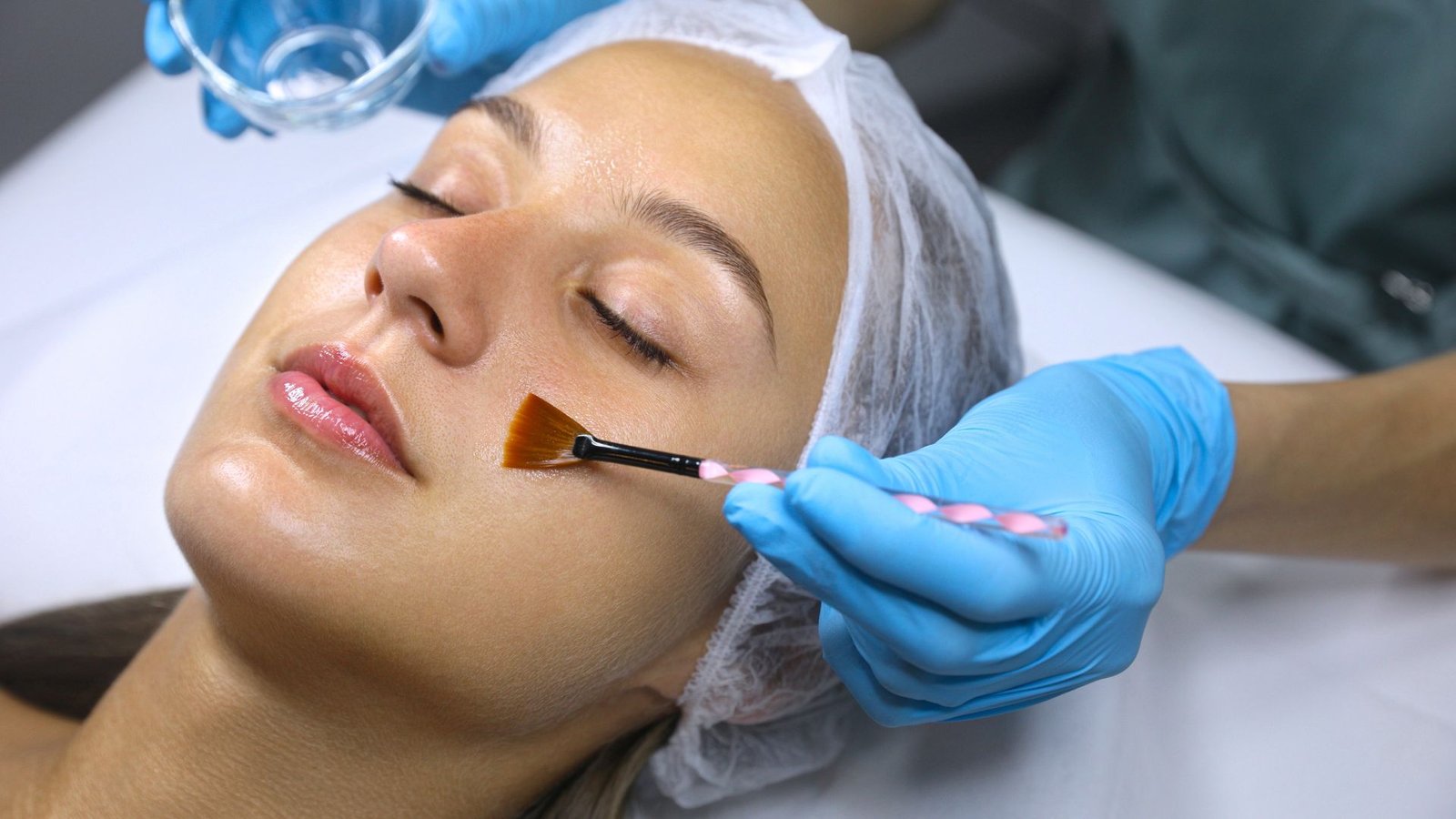Chemical Peel for Skin Whitening: Types, Benefits & Results

Forget everything you thought you knew about skin whitening. It’s not about applying layers of creams or chasing products that promise a quick glow. True skin enhancement begins from the inside out — with something your body is already doing naturally: skin shedding.
A chemical peel is a supervised facial procedure that stimulates your skin to eliminate worn-out, damaged layers, revealing new skin underneath.It accelerates the natural process of exfoliation in a manner creams are not capable of.
Why does it matter? Because most skin whiteners only hide dark patches and dullness. Chemical peels remove dead cells and damaged skin, leaving the skin looking clearer and smoother. That is why they are in demand for skin whitening and skin regeneration.
Your skin sheds approximately 30,000 to 40,000 dead cells per minute. Sometimes it only needs a pick-me-up to accelerate this natural process — chemical peels do just that.
How Chemical Peel Works for Skin Whitening
Skin whitening is not about altering your natural complexion. It’s about exposing fairer, more uniform, and healthier-looking skin.
Chemical peels attack the uneven color, brown spots, and solar damage by dissolving the adhesives that bind dead skin cells together. When they peel off, they carry away years of damage, excess pigmentation, and rough texture.
Chemical peels work similarly to a strong but mild eraser of previous layers, removing dull skin to expose new skin below.
The peel also encourages collagen formation — the protein that makes skin tight and elastic. More collagen equals fewer wrinkles and a smoother topography, which will make skin look younger.
Types of Chemical Peels and Their Depths
Chemical peels come in three levels depending on how deeply they work:
- Superficial Peels: Light exfoliation for mild skin concerns like slight pigmentation and dullness.These peels just touch the outermost layer and are ideal for beginners. Glycolic acid peels are used here.
- Medium Peels: Penetrate deeper to correct textured skin, moderate sun damage, and uneven pigmentation. They take some time off but produce more obvious outcomes.
- Deep Peels: Penetrate more deeply to remedy extreme skin issues such as deep scars and severe pigmentation. Deep peels take more time to heal from and must be applied by experts. Phenol peels are an example.
Picking the peel is akin to picking the perfect level of care. There are peels that give gentle exfoliation, others that go deeper to treat serious skin problems, each with a different healing time.
The optimal peel depends on your skin’s goals and state.
Choosing the Right Peel Based on Skin Type & Concern
Your skin type and issues will impact the peel you select.
Superficial peels with mild acids are also effective on sensitive or dry skin. For textured skin or beginning sun damage, medium peels are effective through the smoothing and evening of tone.
Indian skin and other dark skin tones require cautious evaluation to prevent complications such as hyperpigmentation.
Peels also address fine lines, acne marks, and pigment, making peels a very versatile skin care treatment. To achieve the best results, a dermatologist will prescribe the peel that is best suited to your skin.
What works for one skin type may not suit another, especially for Indian skin tones. Personalised peel choices are key for the best results.
Benefits of Chemical Peels for Skin Whitening
Chemical peels offer several benefits:
- Improved Skin Texture and Tone: Removing the upper layer makes the skin smoother and more even.
- Natural Glow: Peels bring out your own skin’s natural radiance without the aid of filters or makeup.
- Younger-Looking Skin: Collagen stimulation erases fine lines and tightens skin.
- Dark Spot and Pigmentation Reduction: Peels dissolve melanin accumulation, fading recalcitrant spots.
- Hydrated, Balanced Complexion: Certain peels are infused with moisturising agents that soothe and nourish skin after treatment.
Chemical peels impart a healthy glow and smoothness that cannot be achieved through any filter or makeup.
What to Expect During and After Treatment
Your skin is prepared prior to the treatment, and the chemical solution is gently administered.
Within a few minutes, the peel is removed or taken away. Your skin may be flushed or red, like sunburn. In days, pieces of skin peel off by themselves.
The new skin below is new and fragile and requires soft handling such as moisturising and sun protection.
Peeling may appear scary, but it is merely the rebirth of the skin itself, exposing healthier, fresher layers.
Risks & Considerations
Chemical peels are treatments that should only be given by a trained technician to safely and effectively obtain the desired benefits. Chemical peels do have potential side effects such as tightness, redness, and sensitivity.
Some skin types can lead to other complications such as hyperpigmentation if treated ineffectively. Consult dermatologist prior to using any treatment.
Chemical peels are medical procedures demanding maximum caution and professional competence in order to avoid complications and ensure safety.
Chemical Peel Treatment Cost in India
The price of chemical peels in India range from as low as:
- Level of Peel: Superficial peels (or those that target the top layer of the skin), usually cost less and require less downtime to complete. Deeper peels, which go deeper into your skin, involve more steps and longer recovery times, so they are more expensive.
- Location and Reputation of the Clinic: Generally, clinic based in metro cities or in premium market areas tend to charge more as overheads are high and for the clinic’s brand value. Clinics that are run by highly skilled dermatologists and equipment will usually be expensive — although they are safer and produce better results.
- Skin Type & Customisation: Custom treatment plans based on your skin type and concerns might call for special products or additional treatment times for an overall higher cost.
|
Peel Type |
Depth of Penetration |
Common Agents |
Typical Skin Issues Treated |
Downtime |
Average Cost Range (₹) |
|
Superficial Peel |
Outer epidermis |
Glycolic acid, Lactic acid |
Mild discoloration, uneven texture |
Minimal (1-3 days) |
2,000 – 6,000 |
|
Medium Peel |
Upper dermis |
Trichloroacetic acid (TCA) |
Sun damage, moderate pigmentation, rough skin |
Moderate (5-7 days) |
8,000 – 15,000 |
|
Deep Peel |
Lower dermis |
Phenol |
Deep scars, wrinkles, severe pigmentation |
Significant (2+ weeks) |
20,000+ |
On average, superficial peels may range from ₹2,000 to ₹6,000 per session, medium peels from ₹8,000 to ₹15,000, and deep peels can go beyond ₹20,000 depending on complexity.
Investing in a qualified dermatologist’s expertise is crucial to ensure effective and safe treatment.
Who Should Avoid Chemical Peels?
Though chemical peels are ideal for most, they are not for everybody. There are certain conditions and circumstances under which caution or complete avoidance are necessary:
- Active Skin Conditions: Where active infections like cold sores, open broken wounds, eczema, or psoriasis are present, chemical peels would be aggravating the disease or hindering healing.
- Extremely Sensitive Skin: The extremely sensitive or allergy-gland skin can become negatively affected by the acids employed in peels and cause irritation or inflammation.
- Recent Tan or Sunburn: New tanned or sunburned skin peeled can cause possible damage or disorders of pigmentation.
- Some Medications: Certain medications, such as isotretinoin (Accutane), which sensitise the skin make peels not wanted while on it and for a limited time afterwards.
- Dark Skin Tones: While chemical peels are safe on dark skin tones and Indian skin as well, they are risk-prone to post-inflammatory hyperpigmentation if used in a careless manner. Therefore, expert consultation and personalised peel become the need of the hour in order to prevent uneven color of the skin following the treatment.
Best to be honest with your dermatologist regarding your medical history as well as your skin conditions prior to the treatment.
Conclusion
Chemical peels are a simple and effective way of boosting skin texture, reducing hyperpigmentation, and getting clearer, brighter-looking skin by accelerating your own body’s process of renewal.
This therapy is not a matter of changing your natural complexion but a process of removing the destroyed outer layers to reveal a new skin beneath.
It is an exfoliation science-based treatment supplemented with collagen stimulation to impart extended duration of skin benefits.
Selecting the proper type of peel and a well-trained dermatologist are important to achieve the best outcome and to avoid complications. You will have the best results from a tailored plan for your unique skin type and conditions.
Frequently Asked Questions (FAQs)
What is the best chemical peel for whitening the skin?
There is no single fit for all. Superficial and medium-depth peels are routinely prescribed for skin lightening, depending on your concerns and skin type. Your dermatologist will recommend the best course of action after an evaluation.
How many sessions would be required?
Usually, 3 to 6 spaced 3 to 4 weeks apart create significant improvements. This depends on skin condition and peel type.
Is skin damage possible with chemical peels?
When performed by a professional, chemical peels are generally safe. If applied incorrectly or aftercare is neglected, one may develop problems like irritation, burning sensation and pigment change. On average, 3 to 6 treatments, separated by 3 to 4 weeks is required before improvement can be seen.
Is chemical peeling safe for Indian skin tone?
Yes, with proper peel selection and expert supervision, chemical peels can be safe and effective for Indian skin. Careful assessment and customised treatment reduce risks like hyperpigmentation.
Book An Appointment
Related Post





